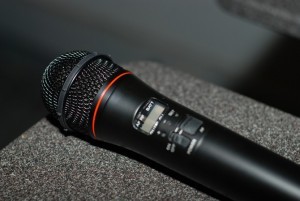 It is not uncommon for the client to provide simultaneous interpretation equipment.
It is not uncommon for the client to provide simultaneous interpretation equipment.
Quality of interpretation equipment is critically important for quality of interpretation, therefore, both interpretation agencies and interpreters should make very clear to the client what constitutes good equipment and how the equipment is to be set up and used professionally.
Sometimes, audiovisual companies and not simultaneous interpretation companies are in charge of equipment, so they may not have enough experience specifically with simultaneous interpretation equipment.
In case of client-provided simultaneous interpretation equipment we recommend the following:
1. Client shall provide at client expense a full house audio feed (it means interpreters should be able to hear all sound sources in the room: speakers, soundtracks, PA, etc) and a complete system for simultaneous interpretation, including appropriate amounts of booths, receivers, headsets, microphones and audio equipment as well as a technician trained in operating simultaneous interpretation equipment to be available immediately before and during the entire event to support our interpreters.
The simultaneous interpretation system shall be compatible with all other audio/video systems used during the event. If speakers plan to move away from the rostrum, a lapel or neck microphone shall be provided to the speakers, otherwise, interpretation may not be possible.
No voice activated microphones shall be used anywhere in the room. Voice activated microphones are extremely difficult to interpret from, because they cut off parts of words, and the sound level is very uneven. Though convenient for other applications, they are completely unsuitable for professional simultaneous interpretation.

Handheld Microphone
2. If portable booths are used, the booths shall be walk-in ISO 4043 compliant isolation booths with doors; booths with curtains or table top booths are not acceptable. There will be no sliding doors in the booths; doors shall open and close silently, there will be no locks or noise making fixtures on the doors.
Booths should be located at the rear of the room, facing the rostrum/screen and shall have direct view of the speakers.
Otherwise, video feed of the speakers shall be provided for all the interpreters on TV/video screens in front of the booth(s) (as well as a separate video feed of easily readable presentations charts/slides if any charts/slides are planned to be used. The video feed shall be directly from the video projector and not a video camera in the conference room.)
The booth floor should be about 1 m (3.3 feet) above floor level for flat floor rooms. Booths shall not be placed in non-standard premises and/or locations (including outside) without preliminary written concurrence by our company.
Booths shall not be placed in too cold or too hot or non-standard environments. Booths shall have adequate silent ventilation as per ISO standards (see above.) Booths shall fit at least 2 interpreters per booth unless only one interpreter is engaged with the total duration of simultaneous interpretation not exceeding thirty (30) minutes.

Yes, some speakers are difficult!
The booths shall be placed where interpreters are not distracted by delegates or conference support personnel. The booth shall be placed where interpreters do not distract delegates or conference support personnel including audio and video production team.
No continuous or intermittent acoustic noise and/or electromagnetic interference sources shall be located near the booths. There will be no interfering noise in the booths from the conference floor.
Each booth shall have adequate lighting (one desk lamp per interpreter with dimmers; the dimmers shall not be sources of audio interference). The lamps shall not: obstruct the view out of the booth, generate too much heat or cause glare into the next booth and/or the conference room or surrounding area or take up too much of the available work-space.
3. The booth shall be equipped with professional interpreter consoles. Announcer panels are not acceptable. The interpreter console shall have a separate microphone on/off switch (lockable) and a separate cough cut button. Consoles with color indication for microphone state (green= off, red= on) are preferred.
The consoles shall provide as a minimum: individual volume control for each headset, channel switching if needed, microphone on/off switch, cough cut button , interpreter console side switch.
All controls shall operate silently.
4. There will be one adjustable, silently operated chair, one headset and one microphone per interpreter (at least two of each per booth). Headset microphones (integrated headset/microphone) are preferred as opposed to table top microphones; however, table top microphones shall be made available if requested by an interpreter. Semi-open headsets are requested.
 The headsets shall be binaural; monoaural headsets are not acceptable.
The headsets shall be binaural; monoaural headsets are not acceptable.
Headphones shall provide dry sound in the range of 125-12,500 Hz., headphone cables shall have at least 1.5 m (5ft) of free cord.
5. If films/videos are to be shown and require interpretation, the interpreters shall receive a copy of the script in advance or have an opportunity to preview the films/videos; otherwise, quality interpretation may not be possible (interpreted at interpreter discretion if the requirement is not met.)
The sound-track shall be directly fed from the projector into the interpreters’ earphones, i.e. not through microphones in the room.
6. Drinking water is requested for all interpreters as needed (bottled, room temperature, no ice.) Trash cans are requested for Interpreters’ use.
If the requirements above are not met, interpreters may not be able to perform interpretation and/or provide sufficient quality.

Finally, please, remember that interpreters are not trying to be difficult by requesting these things. Simultaneous interpretation is extremely complex cognitive activity that requires utmost concentration, and even small distractions or discomfort may be very harmful for quality of interpretation and interpreter comfort. This is not anything excessive or luxurious: interpreters need to be able to concentrate completely on their task i.e. providing the best quality language interpretation for you – their client.
Thank you for your understanding!

